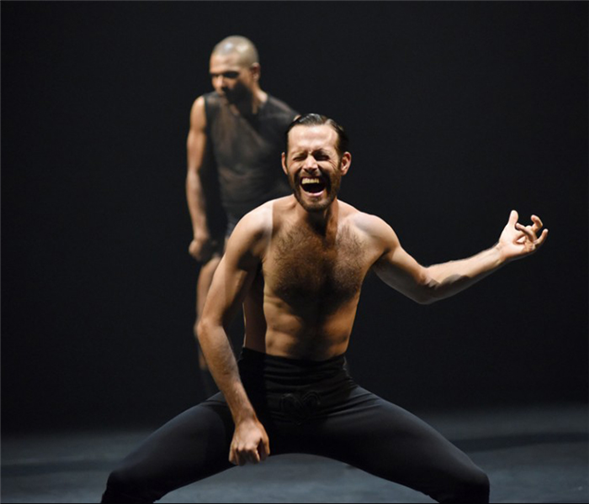Translate Page

Inside the shifting meanings of Sharon Eyal's choreography
---
Sharon Eyal is reticent to nail down the definition of her dance company, LEV, or its newest work, OCD Love, which will have its Joyce premiere from January 11 to 15. Yet when she discusses her art, she assumes she'll be understood. After a curly-cue explanation about her troupe's style, vibe, and visuals, she ends by saying, "You know what I mean?"
And oddly enough, you kind of do. She does, in fact, make an overall sense.
That's also true of her work. If you try to attach meaning to a particular kick or turn, you might feel lost, but if you absorb her pieces as total creations, you can comprehend them on a visceral level.
From that perspective, her elusiveness seems almost necessary, as it always obscures the pieces in favor of the whole. When she's asked, for instance, if LEV's provocative movement can be classified as dance, Eyal says maybe, partly, and not necessarily. Then there's Neil Hilborn's poem OCD, about being in love while handling obsessive-compulsive disorder. Hilborn's work is something of an inspiration for OCD Love, but is the poem what the piece is about? Again: maybe, partly, and not necessarily.
"It's good to be confused," says Eyal, who was born in Jerusalem and named her company after the Hebrew word for heart. "Everything you feel is allowed when watching LEV. The roots are from dance, but it involves everything. All I can truly say about my style is that it's really raw. But really, it's not about style or philosophy or anything lofty in that way. It's comes from inside from my heart and liver."
A former dancer, house choreographer, and associate artistic director with Batsheva, Eyal is deeply informed by that Israeli company's challenging yet approachable art. While working with Batsheva artistic director Ohad Naharin, she began crafting pieces imbued with the bizarre and beautiful movement she showcases now. Some elements – like the feral twitching, thrashing, and swooping – vibrate with the same dualistic energy of Nahrain's work: hectic and somehow healing in its Everyman quality.
This style is indebted to Gaga, a "movement language" Naharin created that is based in awareness, sensation, and imagination. Dancers use the Gaga approach to physicalize, say, that feeling you have when enraged or that particular bubbling of overwhelming joy.
But while these techniques give Eyal roots, they don't entirely define her. "The beauty with Gaga is that it's inside everything," she explains. "It's about life and experience and choice. I learned a lot at Batsheva and got so much inspiration. But one of the most inspiring things from Ohad was that he encouraged me to go my own way."
Her latest venture began when she read Hilborn's ode to how obsessive-compulsive disorder impacts relationships. (Sample verse: "I asked her out six times in thirty seconds/She said yes after the third one/but none of them felt right/ so I had to keep going.") When a friend sent her the poem, however, she didn't immediately run to create a dance about it. "It's processing life, not making dances," she explains. "Things come into my life all the time that are inspiring, whether it's people or a poem or a saying."
She continues, "Everything exists already. All the pieces for a work are already there in the world. Instead, it's all about the intention and how you present those items together. The piece isn't about OCD. It's about beautiful, hard moments. You might have a box, and then you put something else in that box. In that way, the poem is the box, and I put something else inside."
Gai Behar – Eyal's partner in art, life, and business – says this project is particularly resonant for them. "OCD is the trigger, but the piece is not about OCD," he explains. "The poem talks about love and how difficult it can be in any form. For Sharon and I, working and living together is a process in that way. You can see parts of that onstage in New York."
To tease out the shapes in these concepts, Eyal has turned to improvisation. "First, I come into the studio and dancers follow me," she says. "Then, I work with a recording. I watch it, change it, and cut it. At the same time, Gai, [DJ and composer] Ori Lichtik, and [lighting designer] Thierry Dreyfus were creating with me as well. We built it together. We talked a lot about ideas and grew the piece together."
This collaborative style also reflects LEV's overall thrust. "Each time we try to surprise ourselves," Behar says. "The aim is to not get bored and to enjoy the process."
To that end, Eyal sees the first showing of OCD Love as just one station in a longer journey. "There is no feeling of 'It is done,'" she says. "This is a moment of something to show and perform, and it will keep growing."
This applies to the entire troupe as much as the current work. "LEV is like a diamond," Eyal says. "You continue to shape it, and it becomes more clear and colorful. You go deeper into your process, learning what you love. And what I love is the human beings I'm working with. It's a lot about the process and the time spent together. I can dream of what I want to do because of the people around me."
---
Lauren Kay frequently writes about dance for TDF Stages and directs the Meet the Dance Company film series.
Photos by Regina Brocke. Top photo: A scene from OCD Love.
TDF Members: Go here to browse our latest offers for dance, theatre, and concerts.